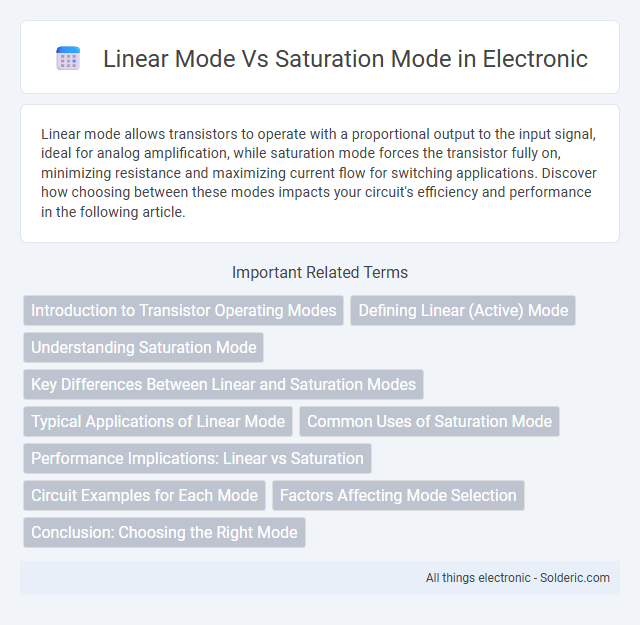Linear mode allows transistors to operate with a proportional output to the input signal, ideal for analog amplification, while saturation mode forces the transistor fully on, minimizing resistance and maximizing current flow for switching applications. Discover how choosing between these modes impacts your circuit's efficiency and performance in the following article.
Comparison Table
| Aspect | Linear Mode | Saturation Mode |
|---|---|---|
| Definition | Device operates in its linear region, output proportional to input. | Device operates beyond linear region, output saturates at max value. |
| Output Behavior | Continuous and proportional to input signal. | Clipped or limited output regardless of increases in input. |
| Use Case | Precise amplification and signal processing. | Signal limiting, protection circuits, and switching. |
| Distortion Level | Low distortion, faithful signal representation. | High distortion due to clipping or output limits. |
| Power Efficiency | Lower power efficiency due to continuous operation. | Higher efficiency in switching or limiting applications. |
| Example Devices | Amplifiers operating within linear range. | Transistors in saturation region, voltage regulators. |
Introduction to Transistor Operating Modes
Transistor operating modes, primarily linear mode and saturation mode, define how a transistor controls current flow in electronic circuits. In linear mode, the transistor operates as an amplifier with a controlled, proportional output current based on the input signal, ideal for analog applications. Saturation mode occurs when the transistor is fully on, allowing maximum current flow, which is essential for switching applications like digital logic and power control.
Defining Linear (Active) Mode
Linear mode, also known as active mode, occurs when a transistor operates with the collector-emitter voltage sufficiently high to keep the transistor partially on, allowing it to function as an amplifier. In this mode, the transistor maintains a controlled current flow proportional to the base current, offering precise modulation of output signals. Linear mode is critical in analog circuits where accurate signal amplification without distortion is required.
Understanding Saturation Mode
Saturation mode occurs when a transistor's base-emitter junction is forward biased and the base-collector junction is also forward biased, causing the transistor to conduct maximum current from collector to emitter. Unlike linear mode, where the transistor acts like a variable resistor controlled by the base current, saturation mode forces the transistor into a low-resistance state, minimizing voltage drop across the collector-emitter terminals. Understanding saturation mode is crucial for switching applications where your device needs to operate fully on, ensuring efficient current flow with minimal power loss.
Key Differences Between Linear and Saturation Modes
Linear mode allows a transistor to operate as a variable resistor, enabling precise control of current flow between the collector and emitter, ideal for amplification purposes. Saturation mode drives the transistor fully "on," minimizing voltage drop and allowing maximum current flow, essential for switching applications. Understanding these key differences helps optimize your circuit design for either amplification or switching functionality.
Typical Applications of Linear Mode
Linear mode is predominantly used in applications requiring precise control of output, such as audio amplifiers, voltage regulators, and analog signal processing circuits. It excels in scenarios where low distortion and fast response are critical, making it ideal for sensor interfaces and operational amplifiers. Your design benefits from linear mode when maintaining signal fidelity and steady voltage levels in electronic systems.
Common Uses of Saturation Mode
Saturation mode is commonly used in switching regulators and power amplifiers to maximize output power and efficiency by fully turning on the transistor. This mode allows devices to act as low-resistance switches, minimizing voltage drop and heat generation during conduction. Your circuits benefit from saturation mode when operating at higher currents and switching speeds, ensuring optimal energy transfer and reduced power losses.
Performance Implications: Linear vs Saturation
Linear mode offers efficient switching with minimal power loss, making it ideal for applications requiring precise voltage regulation and low heat dissipation. Saturation mode provides faster switching speeds and higher current handling but often results in increased power dissipation and thermal stress. Understanding these performance implications helps you select the appropriate mode based on your system's efficiency and heat management requirements.
Circuit Examples for Each Mode
In linear mode, MOSFETs are commonly used in analog circuits such as voltage regulators and amplifiers where the transistor operates as a variable resistor, exemplified by the source follower configuration. Saturation mode is prevalent in digital switching circuits like CMOS inverters and logic gates, where the MOSFET acts as a switch fully turned on or off for efficient signal propagation. Examples include common-source amplifiers operating in saturation for maximum gain and MOSFET switches in power management circuits leveraging linear mode for precise control.
Factors Affecting Mode Selection
The selection between linear mode and saturation mode in transistors depends on factors such as the desired output characteristics, load resistance, and input signal amplitude. Linear mode is preferred for amplification where the transistor operates within the active region, providing a proportional output, whereas saturation mode is used for switching applications, ensuring the transistor is fully on with minimal voltage drop. Your circuit requirements, including speed, power dissipation, and signal distortion tolerance, critically influence which mode is optimal for performance.
Conclusion: Choosing the Right Mode
Choosing the right mode between linear and saturation depends on your specific application and performance requirements. Linear mode provides precise control and low distortion, ideal for applications needing accurate amplification, while saturation mode offers higher output power and efficiency, suitable for switching and power delivery tasks. Understanding your circuit's demands will help you optimize efficiency, linearity, and overall system performance.
Linear mode vs Saturation mode Infographic

 solderic.com
solderic.com